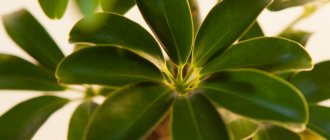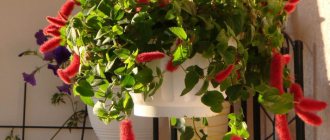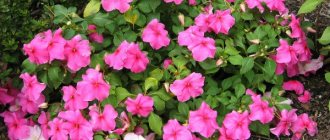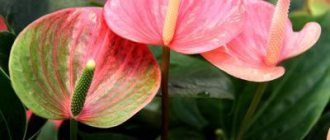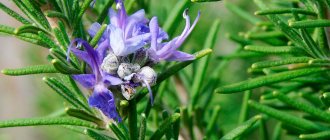Guzmania is a herbaceous evergreen plant that grows on the ground or grows on other crops. This plant, which is a member of the Bromeliad family, is also called guzmania. The Bromeliad genus consists of 130 species. The tropical plant grows in the vast expanses of Brazil, the West Indies, Venezuela, Central America and southern Florida. Guzmania prefers mountain peaks.
The plant received its name in 1802 in honor of the naturalist, biologist, and Spanish pharmacist A. Guzman, who studied South America.
Flower growers actively grow a huge number of guzmania species.
The flower captivates viewers with its eye-catching rosette, which consists of long leaves. And the amazing inflorescence of the crop is shaped like a pine cone. However, fans consider the long-lasting flowering to be the main unique feature of Guzmania.
It is believed that guzmania can relieve tension and stress in the owners, gives positive emotions, and fills them with mental strength. The plant helps cope with sleep disorders and nightmares.
In the homeland of the flower, people are sure that the plant gives extraordinary strength to men: physical, emotional, sexual. Therefore, the plant is started at home and placed in the bedroom.
Description and photo of a plant in a pot
Guzmania is a tropical forest herbaceous plant named after the Spanish botanist Guzman. It belongs to the Bromeliad family and is an epiphyte.
The plant receives water and nutrients from the atmosphere, and underdeveloped roots are needed only to cling to the bark of trees.
Long, narrow leaves form a rosette, in which, like in a glass, rainwater accumulates, used by the flower.
The following is a photo of a flower in a pot:
Reproduction methods
Guzmania is propagated by lateral shoots, sometimes by seeds.
Offspring
After flowering, the plant slowly fades, laying buds at the base that produce offspring. After just a couple of months, the baby rosettes have their own 3-4 leaves and a weak root system, without which it is impossible to separate them. After flowering is completed, cut off the dried old rosette and carefully, without separating, transplant all the little ones into a new substrate.
It is important not to bury the root collar: the plant will be much more magnificent than before. You can use a sharp knife to separate the babies from the mother’s outlet and plant them in small, wide, low containers with fresh soil, not forgetting about a good drainage layer. New “sultanas” are covered with glass or plastic to create a greenhouse and placed on the sunny side, where the temperature should be +26...+28 degrees. In a couple of years, the children will already bloom, and more readily in cramped pots.
Seeds
Guzmania is propagated not only by offspring, but also by seeds. The planting container is filled with a substrate intended for bromeliads, which consists of sand and crushed peat. The seeds are washed with a solution of potassium permanganate, dried thoroughly, then evenly spread over the surface of the soil. They are not buried in the ground, because in order for the seeds to sprout, they need a considerable amount of light. The surface of the container is covered with film or glass, creating a “greenhouse effect”.
Next, the container is placed in a warm room, the air temperature in which should be at least +22 degrees. It is important to regularly ventilate the plantings and moisten the soil with warm water. The first shoots will form in 2-3 weeks. As soon as the sprouts reach 10 weeks of age, they are picked. After 15 days, the bushes are planted in permanent containers. Plants grown from seeds will bloom in 3-5 years.
Bloom
Guzmania blooms only once, after which it dies . However, the flowering itself is long-lasting and lasts up to six months. The time and duration of flowering depend on the type of plant. In the center of the leaf rosette a peduncle is formed, at the top of which there are bright bracts. They can be red, yellow, orange and even purple.
The flowers themselves are small, inconspicuous, white, collected in a spike-shaped inflorescence.
Varieties
There are more than a hundred species of Guzmania in nature, but not all have taken root in indoor floriculture. Here are some of them.
Donnell Smith
Its bracts have a bright yellow tint. Flowering lasts up to six months, starting in early April. This species can easily reproduce by seeds .
Blood red
It differs in that during the flowering period the entire rosette turns purple-red. Long leaves bend down. Flowering is long, from April to August.
Mosaic
The striking striped leaves of this species are very decorative . Flowering lasts from April to June, the bracts are bright pink and wide.
Tongue
One of the most popular types. The leaves are long, bright green, and the flower stalk is small, with red or orange bracts. Its hybrid is Guzmania Minor, which is more compact.
Single-haired
Very decorative. Its inflorescence is in the form of a spike, and the peduncle changes color towards the top, from green to scarlet.
Nicaraguan
Very compact, red-brown inflorescence with lemon flowers at the top. Blooms profusely but briefly in spring .
Types of indoor guzmanias
The most popular varieties are the spectacularly flowering species of Guzmania lingulata. Graceful star-shaped funnels of rich green leaves and bright orange-red star-shaped inflorescences are showy and eye-catching. You should choose varieties based on the color of the leaves and inflorescences, the height and shape of the rosette - to your taste. There are charming miniature varieties that are grown in groups and plants with unusual flowering.
Blood-red Guzmania (Guzmania sanguinea) attracts with its almost sessile inflorescence in a rosette with narrow red bracts and wide, often striped leaves.
Guzmania musaica impresses with beautiful long, up to 70 cm, leaves in a very spreading rosette with unique “zebra” variegated patterns. Small capitate inflorescences are simple, with bright pink bracts.
Blood red Guzmania (Guzmania sanguinea). © bromeliad
Guzmania lingulata. © tonielias1971
Guzmania mosaic (Guzmania musaica). © Peter Sargent
Guzmania monostachia is an attractive plant with narrow and softer light-colored leaves and elongated red and white spikelets.
Guzmania zahnii flaunts bending lanceolate leaves with a longitudinal light stripe illuminated with a pink stroke and a red-yellow compact inflorescence.
Guzmania , is also receiving increasing attention .
Guzmania monostachia. © Peter Tristram
Guzmania dissitiflora. © pow_pots
Guzmania zahnii. © Keith Edkins
Home care
Guzmania is not a very picky plant, but there are certain nuances in caring for it that you definitely need to know.
- The flower prefers diffused lighting. The best places for it will be the western and eastern windows. The plant should be protected from direct sunlight to prevent leaf burns.
- Guzmania is thermophilic. The best temperature for it will be 20-25°C in summer and 17-20°C in winter. When the temperature drops below 15°C, the plant may become sick.
- The plant loves high humidity, so it is better to keep it away from heating devices and spray it daily with warm, settled water.
- Guzmania should be watered only with warm, filtered or settled water. In summer, the liquid is poured directly into the rosette of leaves and left until completely absorbed. In winter, the remaining water is drained. In the hot season, the plant requires watering daily, and in the cold season, 2 times a week is enough. Guzmania does not tolerate stagnation of water, and may die from this.
- The plant does not require abundant feeding. However, in the spring-summer period, for better flowering, guzmania can be fed once a month. Fertilizers for bromeliads or orchids are suitable. The fertilizer, diluted 2 times weaker than indicated, is poured into the rosette of the flower or under the root.
Growing conditions for indoor guzmania
Guzmanias adapt so well to light and are so thermophilic that they seem created specifically for interiors. They can be placed in light or semi-shaded areas of the interior, and on window sills. Guzmanias need protection from direct sun; they do not tolerate strong shading, but they tolerate light fluctuations well. In winter, when flowering, it is better to increase the lighting.
Western window sills are considered the ideal place. Guzmanias look great as living bouquets and tabletop accents.
Even in winter, the temperature for these plants should not fall below 18 degrees. They are not afraid of heat (up to 28 degrees) and feel great in living rooms. The optimal mode is 25 degrees during active growing season and 20-21 degrees during flowering.
Guzmanias love good air circulation and frequent ventilation; they need to be placed separately and freely. The plant is not afraid of warm drafts. In summer you can take it out into the open air in protected places.
Western window sills are considered the ideal place for guzmania. © Taman Inspirasi
Diseases
If the plant is not properly cared for, it may get sick.
- Fungal diseases can be caused by high humidity combined with improper temperature conditions. If gray spots appear on the leaves of a plant, this is gray rot. In this case, the flower must be treated several times with a fungicide.
- Excessive watering may cause rotting of the roots and stems. Watering should be temporarily reduced, otherwise the plant will die. As a last resort, the guzmania is removed from the pot, the rotten areas are cut off, dried and the plant is planted in new soil.
Possible problems
In the process of cultivating guzmania, a grower may encounter a number of problems:
- Root rotting. The reason for the rotting of the plant's root system is excessive watering, so irrigation of the crop must be dosed.
- Fungal diseases. If the plant is kept in a very warm and humid room, the risk of it being affected by fungal diseases increases.
- Brown and yellow spots on the leaves. Brown spots on the leaf blades indicate sunburn, and if the tips of the leaves turn brown, then the air contains little moisture.
- Change in color of leaf tips. Changes in the color of the tips of the leaves can be caused by watering with hard water or a lack of water in the outlet. If yellow spots have formed on parts of the plant, it means that the flower is attacked by a red spider mite. In this case, if urgent measures are not taken to save the plant, the leaves will gradually turn completely yellow and die.
- The formation of chestnut growths on the leaves tells the grower about a bromeliad scale infestation.
- White coating on leaf blades. The formation of a white coating similar to cotton wool indicates the activity of mealybugs.
- Soft leaves. Sloping, flabby leaves indicate a low temperature in the room in which the guzmania lives.
- Burns. The appearance of burns on parts of the plant depends on exposure to direct sunlight, so the flower is placed only under scattered sultry rays.
- Lack of flowering. It happens that for some reason an exotic beauty does not bloom. In this case, there is a method of stimulation: you need to put a couple of very ripe apples and bananas next to the pot, and hermetically cover them all together with plastic wrap for a day. Then remove the cover for a couple of hours and wrap it with film again. Continue this procedure for several days. When fruits ripen, they release ethylene gas, which promotes flowering, so the results will not be long in coming.
Similar crops
All plants of the Bromeliad family, belonging to the group of epiphytes, have some similarities in structure and appearance. All of them form a rosette of leaves with a spectacular peduncle in the middle. These are flowers such as:
- vriesia;
- ehmeya;
- bromeliad;
- tillandsia.
Guzmania is an interesting and beautiful flower that comes in many spectacular varieties. If you know all the intricacies of proper care for it, guzmania will not cause any trouble and will decorate any room.
Description
All representatives of the Bromeliad family have a common feature: the leaves of the plants overlap each other closer to the base, forming something like a bowl for water. The bowl accumulates water, which is used by the flower for personal life. Under natural conditions, this water is also used by forest inhabitants.
Typically, the leaves of the crop are of the same shade, but there are species with transversely or longitudinally striped leaves. The length of the leaves varies depending on the species up to 0.7 meters. The leaves form a rosette, which reaches 50 centimeters in diameter, but there are species that differ in both smaller and larger rosette sizes.
Different species have peduncles of different lengths.
The flowering time begins in March or September and lasts for six months. After six months of flowering, guzmania dies.
Guzmania flowers are inconspicuous, while the bracts are striking, as if varnished, painted in lemon, carrot, scarlet or snow-white, up to 50 millimeters long. Such bracts form an original inflorescence. The height of a mature bush is 0.75 meters, width up to 0.6 meters. At home, the height of guzmania rarely exceeds 0.4 meters.
To grow a crop indoors, it is important for plant fans to know how to properly care for it. The flower loves warmth, grows and develops only with high air humidity and needs bright, but diffused light without direct rays of the sun.



